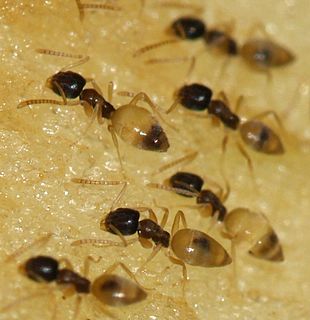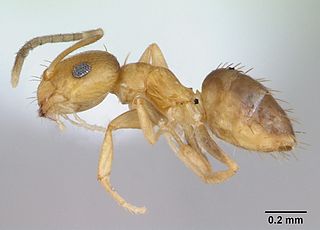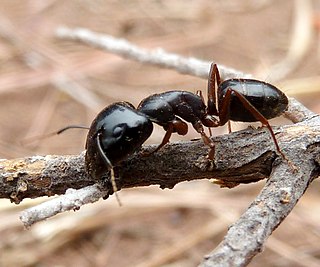Related Research Articles

Dorylinae is an ant subfamily, with distributions in both the Old World and New World. Brady et al. (2014) synonymized the previous dorylomorph subfamilies under Dorylinae., while Borowiec (2016) reviewed and revised the genera, resurrecting many genera which had previously been merged. Dorylinae genera are suggested to have evolved sometime between 102 to 74 million years ago, subsequently undergoing rapid adaptive radiation events during their early history.

Tapinoma is a genus of ants that belongs to the subfamily Dolichoderinae. The genus currently comprises 74 described species distributed worldwide in tropical and temperate regions. Members of are generalized foragers, nesting in a wide variety of habitats, ranging from grasslands, open fields, woodlands, to inside buildings. The majority of species nest in the ground under objects such as stones or tree logs, other species build nests under bark of logs and stumps, in plant cavities, insect galls or refuse piles.

Brachymyrmex is a genus in the ants subfamily Formicinae. The genus can be recognized by the combination of having nine antennal segments and the petiole concealed by the gaster in dorsal view. They are sometimes called "rover ants".

Aenictus is a large army ant genus distributed in the Old World tropics and subtropics. It contains about 181 species, making it one of the larger ant genera of the world.

Aenictus ceylonicus is a species of reddish brown army ant found in Southern India, Sri Lanka, Southeast Asia and Australia. They are completely blind and around 3 mm in length. These ants are seen foraging underneath leaf litter in forests and well-vegetated areas, travelling in a trail of in three or more columns alongside each other, in parts of India. Their antennae, as in most species of Aenictus, have ten segments. The scape is long and extends above the head. The head is smooth and shiny. The mesosoma and the head region are dark brown, while the gaster is oval and lighter in colour, nearly translucent. The mesosoma is broad anteriorly and strongly compressed posteriorly. The petiole and the post petiole are large, conical and shining. They occur in rainforests and moist deciduous forests building temporary nests on the ground and in rotting logs.

Ypresiomyrma is an extinct genus of ants in the subfamily Myrmeciinae that was described in 2006. There are four species described; one species is from the Isle of Fur in Denmark, two are from the McAbee Fossil Beds in British Columbia, Canada, and the fourth from the Bol’shaya Svetlovodnaya fossil site in Russia. The queens of this genus are large, the mandibles are elongated and the eyes are well developed; a stinger is also present. The behaviour of these ants would have been similar to that of extant Myrmeciinae ants, such as solitary foraging for arthropod prey and never leaving pheromone trails. The alates were poor flyers due to their size, and birds and animals most likely preyed on these ants. Ypresiomyrma is not assigned to any tribe, and is instead generally regarded as incertae sedis within Myrmeciinae. However, some authors believe Ypresiomyrma should be assigned as incertae sedis within Formicidae.

Aenictus brevipodus is a species of ant in the Dorylinae subfamily. It was first described in 2013 by Weeyawat Jaitrong and Seiki Yamane.

Cerapachys is a genus of ants in the subfamily Dorylinae. Species are mainly myrmecophagous ants which raid the nests of other ants for prey. The genus is distributed widely throughout the Indomalayan region. The genus was revised by BoroWiec (2016) who split a number of previously synonymized genera out of Cerapachys, leaving only 5 species in the genus.

Cardiocondyla pirata, or pirate ant, is a species of ant in the subfamily Myrmicinae. Known from the Philippines, the female castes show a pigmentation pattern not known from any ant worldwide. Little is known about their biology.
Dinoponera mutica is a queenless species of ants in the subfamily Ponerinae.

Dinoponera quadriceps is a queenless species of ants in the subfamily Ponerinae. The species, known from Brazil, is similar to Dinoponera mutica and uses venom for subduing large live prey and defense. Its venom could be of use to the pharmaceutical industry.
Dinoponera snellingi is a queenless species of ants in the subfamily Ponerinae. The species is known only from type locality in Campo Grande, Brazil.
Dinoponera hispida is a queenless species of ants in the subfamily Ponerinae. The species is known only from the type locality in Tucuruí, Pará, Brazil.

Dinoponera lucida is a large queenless species of ant in the subfamily Ponerinae. The species, endemic to Brazil, is threatened by habitat destruction. Workers range from 27 to 30 mm in body length, which is slightly larger than the related species Dinoponera australis, but smaller than other large ants. Males are unknown.

Lordomyrma reticulata is a species of ant in the subfamily Myrmicinae.
Stenamma andersoni is a Neotropical species of ant in the subfamily Myrmicinae.
Anochetus brevidentatus is an extinct species of ant in the subfamily Ponerinae known from two possibly Miocene fossils found on Hispaniola. A. ambiguus is one of eight species in the ant genus Anochetus to have been described from fossils found in Dominican amber and is one of a number of Anochetus species found in the Greater Antillies.

Camponotus empedocles is a large and dark species of carpenter ant with an extensive range in the Afrotropics.

Colobopsis explodens is a species of ant which is found in Southeast Asia. It is noted for a rare combat mechanism of workers exploding in self-defense, smothering the enemy with toxic and often deadly secretion.
References
- Jaitrong, W., Yamane, S. & Wiwatwitaya, D. (2010). "The Army Ant Aenictus wroughtonii and related species in the Oriental region, with descriptions of two new species.". Japanese Journal of Systematic Entomology16: 33-36.
-
 This article incorporates text from a scholarly publication published under a copyright license that allows anyone to reuse, revise, remix and redistribute the materials in any form for any purpose: Staab, M. (2014). "A new species of the Aenictus wroughtonii group (Hymenoptera, Formicidae) from South-East China". ZooKeys (391): 65–73. doi: 10.3897/zookeys.391.7213 . PMC 3974444 . PMID 24715780. Please check the source for the exact licensing terms.
This article incorporates text from a scholarly publication published under a copyright license that allows anyone to reuse, revise, remix and redistribute the materials in any form for any purpose: Staab, M. (2014). "A new species of the Aenictus wroughtonii group (Hymenoptera, Formicidae) from South-East China". ZooKeys (391): 65–73. doi: 10.3897/zookeys.391.7213 . PMC 3974444 . PMID 24715780. Please check the source for the exact licensing terms.